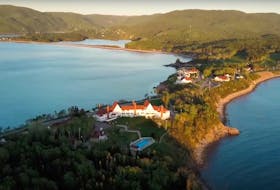North Atlantic right whales will soon begin their seasonal migration, heading from the warm waters of the southern United States to spend the summer and fall in Atlantic Canada.
To prepare for the arrival of the endangered mammals — there are only 366 or so of them left in the world — the Department of Fisheries and Oceans (DFO) today revealed the measures for 2021 to protect the whales from fishing gear entanglements and collisions with ships.
Fishing rules for 2021
Continuing the guidelines for 2020, fishing areas will be closed in 2021 wherever and whenever North Atlantic right whales are present in the Gulf of St. Lawrence, Bay of Fundy, and the Roseway Basin Critical Habitat.
Last year closures of fishing zones affected some snow crab harvesters in the Gulf region in the spring.
According to DFO, fishers were able to move to other parts of their fishing zone to set crab pots.
Closures in the Bay of Fundy and Rosewood Basin also affected lobster and other fisheries.
For 2021, the department is employing new criteria for zone closures, to try to find a better balance between whale protection and fishing activity.

Last year certain areas of the Gulf — known as the dynamic zone — were closed if a right whale was spotted just once in the area.
This year, a right whale will need to be visually or acoustically detected a second time in a closed zone, from days 9 to 15 of the closure, before the closure will be extended for another 15 days.
In the Bay of Fundy and critical habitats in the Roseway and Grand Manan basins, if a whale is detected again during days 9-15, a temporary closure of an additional 15 days will be applied.
In the Gulf of St. Lawrence (including around Anticosti Island, the Cabot Strait, as well as the Strait of Belle Isle), if a whale is detected again in a closed area during days 9-15, a season-long closure will be implemented; the area will remain closed until November 15, 2021.
If a whale is not detected again in a closed area during days 9-15, the area will reopen to fishing after day 15.
Fisheries and Oceans Canada says it is also establishing a new technical working group for harvesters, right whale experts, and departmental officials for regular, in-depth, discussions to ensure continued improvements of the measures for right whale protection.
Meanwhile, harveters are required to report lost gear, and report any accidental contact between a marine mammal and a vessel or fishing gear.

Marine traffic rules
Transport Canada also regulates marine traffic rules to vessels using the area inhabited by right whales.
Most of the vessel management measures for 2021 are the same as last year.
They include a mandatory speed restriction to a maximum of 10 knots when travelling throughout much of the Gulf of St. Lawrence, and a voluntary slowdown of 10 knots for vessels traveling through the Cabot Strait from April 28 to June 29, and from Sept. 29 to Nov. 15, the times when larger numbers of the whales are migrating in or out of the Gulf of St. Lawrence.
The department said fines of up to $250,000 will be issued to vessels that are non-compliant with the mandatory vessel traffic management measures put in place for this year.
There are two changes from 2020.
For 2021, the mandatory restricted area in and near the Shediac Valley will be refined by size, location and duration to better protect right whales at times when greater numbers of them are expected to be in that area.
The timing and exact co-ordinates of this zone are being confirmed and will be communicated to mariners once finalized.
The speed limit exemption in waters of less than 20 fathoms will also be expanded to all commercial fishing vessels.
The vessel traffic measures will be in effect from April 28 to Nov. 15. According to Transport Canada, four penalties were issued in 2020 for non-compliance with speed restrictions.

Tracking and testing
The DFO and Transport Canada employ several methods to track the whales in Canadian waters.
In addition to aerial surveillance using airplanes and drones — they logged 2,500 hours of air time last year — the government also uses acoustic buoys to detect whale sounds.
Last year, they also use an underwater glider to track whales. This year, they will deploy two automated underwater vehicles (AUV) to search for the animals.
Working with fish harvesters, the DFO is also testing "whale safe" gear, like ropeless lobster pots, to reduce the risk of whale entanglement.
Canada is spending millions to study and protect whales.
In budget 2018, $167.4 million was earmarked for a Whales Inititaive to help protect and support the recovery of endangered whale species.
Another $4.5 million was allotted for the Maritime Mammal Response Program, which responds to marine mammals in distress, including freeing right whales that become entangled in fishing gear.
Reaction
A Canadian conservation group, sees some good things in the measures announced for 2021 to protect right whales.
Kim Elmslie, campaign director for Oceana Canada, told SaltWire the addition of acoustic buoys in the Cabot Strait should help increase knowledge about right whale activity in that busy shipping lane.
The group also supports the new criteria to be used to determine whether to open a fishing zone, or continue a closure after the detection of right whales.
Last year, she said, a single sighting of a right whale could close a fishing area for the season.
This year, there would have to be a second sighting of a right whale in a fishing area within the certain time period before the zone closure could be extended.
“I think what they’re trying to balance out is the protection of the whales with the protection of fishing interests.
“I think we’re all hoping to find that shipping, fishing and whales can co-exist.”
There are some things lacking in the rules for 2021, however, according to Elmslie.
Find out more about the North Atlantic right whale here.
One of the things Oceana had called for, she said, was mandatory speed limits in the Cabot Strait.
“Last year they introduced a voluntary slowdown. We (Oceana) found that 60 per cent of the vessels in that area were still traveling at a speed of more than 10 knots.”
“For those measures to be truly effective it needs to be mandatory,” she said.
“This is an animal heading to extinction,” she added. “There are only about 380 left in the world … so this is the time to pull out all the stops to protect it.”








